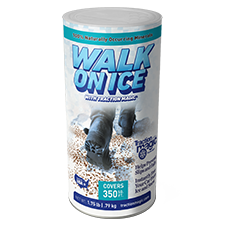Concrete Pavers? Here’s How To Melt Ice
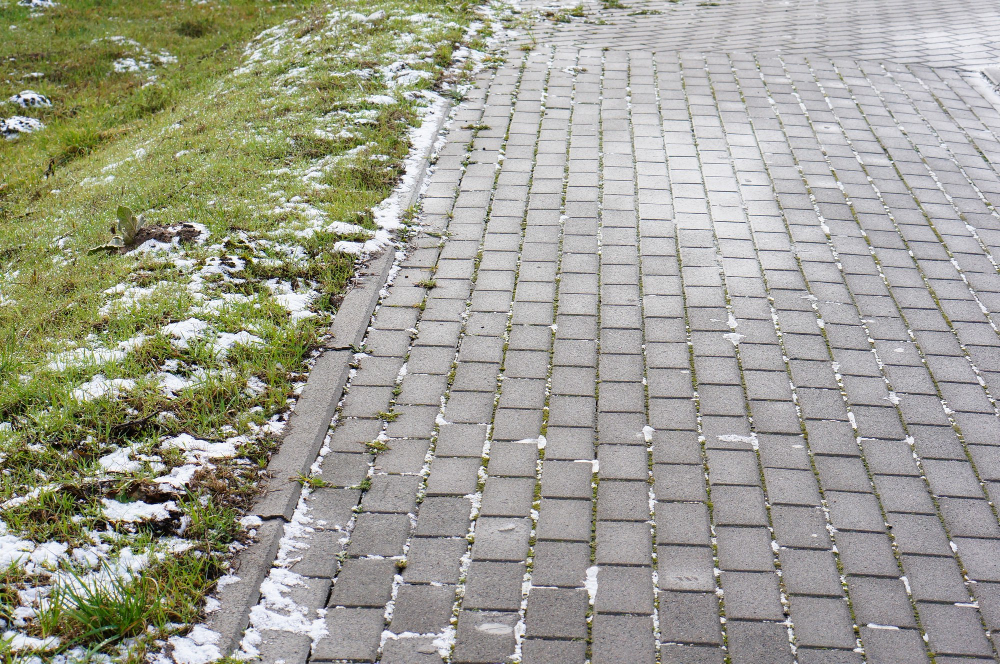
Many property owners love to have a magnificent paver driveway or walkway with cheerful colors, rich textures, and antique patterns. And they want to maintain its eye-catching beauty throughout the year, particularly during winters, by protecting it from ice and snow and the harms of ice melt. You should know which ice melting product is the best ice melt for pavers and how to melt the ice.
Understanding the best ways to prevent the pavers from the effect of snow and ice is vital. Let us learn more about the safest ice melt for concrete and why we need them.
Best Ice Melt for Pavers: Here’s How to Melt Ice Effectively
Winter brings the challenge of keeping driveways, patios, and walkways safe and ice-free. For those with concrete pavers, choosing the right ice melt is crucial to prevent damage while ensuring safety. From understanding the environmental impact of deicers to exploring non-chemical methods, this guide provides everything you need to know about melting ice on pavers effectively and responsibly.
How to Melt Ice Without Damaging Concrete?
Concrete, including pavers, is a porous material, which means it can absorb water and any substances mixed with it. Using traditional ice melt products containing chlorides can lead to surface damage and pitting over time. Here’s how to melt ice without harming your concrete:
1. Choose Chloride-Free Ice Melt: So, what ice melt is safe for concrete? Opt for a chloride-free ice melt like Safe Thaw. This type of ice melt is safe for concrete surfaces, preventing damage and extending the life of your pavers.
2. Apply the Right Amount: Avoid overapplication of ice melt, as excess product can lead to concrete damage. Follow the recommended application rates provided by the manufacturer.
3. Sweep Away Excess Ice Melt: After the ice has melted and the area is safe to walk on, sweep away any remaining ice melt. This helps prevent prolonged exposure to the product, which can potentially affect the concrete surface.

Best Ice Melt For Pavers
Generally, all deicing products lower the freezing point of the water brine, that’s why they all seem to be the same, but this is not the reality. The ice melting products are prepared with different kinds of chemicals, and so some are safe while others are not. Here is the information that might help you to choose the safest ice melt for concrete pavers.
- Sodium Chloride (Rock Salt): Rock salt is a traditional ice melt available at a lower price. Still, it cannot perform at a temperature below 25 °F, and it can damage the concrete due to freeze-induced expansion pressure built during freeze/thaw cycles of the ice melt process, leaving a white powdery residue.
- Calcium Chloride: It is relatively less harmful and performs faster than Rock Salt at a low temperature of -25 °F. Calcium chloride is less toxic to the vegetation; however, it is still detrimental to concrete and metal as it leaches out moisture and some chemicals, leaving a white powdery residue.
- Magnesium Chloride: It is expensive and preferred for domestic use only due to its pet-safe quality. However, it is ineffective at shallow temperatures and can work at a minimum of -5°F temperature. In addition, magnesium chloride is a water-based product that is only 48% active and becomes ineffective quickly.
- Urea: Urea is commonly known as a fertilizer but is also one of the best ice melt. It combines carbon dioxide and ammonia and contains 46% Nitrogen. As a result, urea is the safest deicer and an excellent choice for people who want to avoid salt and chloride’s side effects on concrete pavers.
Environmental Impact of Deicing Agents
Traditional deicing agents are effective at melting ice but often come with significant environmental consequences.
Soil and Water Contamination
When deicing salts, like sodium chloride and calcium chloride, dissolve, they can seep into the soil, altering its composition and harming vegetation. Runoff from these chemicals also pollutes nearby water sources, increasing salinity and disrupting aquatic ecosystems.
Air Quality Concerns
Certain deicing agents release fine particulate matter into the air, contributing to localized air pollution. This can affect both the environment and respiratory health in humans and pets.
The Role of Eco-Friendly Ice Melts
Switching to environmentally friendly products, such as Safe Thaw or other chloride-free options, minimizes these impacts. These products are biodegradable, safe for plants and water systems, and effective at melting ice without damaging the surrounding ecosystem.
Safety Considerations for Pets and Children
The safety of your household should be a top priority when choosing an ice melt.
Risks of Traditional Deicers
Many conventional ice melts contain chemicals that can irritate pets’ paws or harm them if ingested. Similarly, children playing outside may accidentally come into contact with these substances, risking skin irritation or ingestion.
Non-Toxic Alternatives
Opt for ice melts specifically labeled as pet- and child-safe. Products like Safe Thaw are free of harmful chemicals and provide effective ice control without endangering your loved ones.
Importance of Proper Application
Even when using safe ice melts, apply them sparingly to avoid unnecessary exposure. Sweep up excess product after the ice melts to maintain a clean and safe surface for pets and children.
Comparative Analysis of Ice Melt Products
Not all ice melts are created equal. Here’s how different products compare:
Sodium Chloride (Rock Salt)
- Effectiveness: Melts ice effectively at temperatures down to 20°F.
- Impact on Pavers: Can cause scaling, spalling, and discoloration on concrete pavers.
- Environmental Impact: High; runoff contaminates soil and water.
- Cost: Affordable but may lead to costly repairs.
Calcium Chloride
- Effectiveness: Works at temperatures as low as -25°F.
- Impact on Pavers: Less harmful than sodium chloride but can cause surface damage with excessive use.
- Environmental Impact: Moderate; runoff can affect soil health.
- Cost: Higher than sodium chloride.
Magnesium Chloride
- Effectiveness: Effective at temperatures down to -13°F.
- Impact on Pavers: Gentler on pavers but still not ideal for long-term use.
- Environmental Impact: Less toxic but not completely eco-friendly.
- Cost: Mid-range.
Chloride-Free Options (e.g., Safe Thaw)
- Effectiveness: Performs well in low temperatures while being gentle on concrete pavers.
- Impact on Pavers: Safe for all surfaces, including pavers and composite decking.
- Environmental Impact: Minimal; biodegradable and non-toxic.
- Cost: Slightly higher but worth the investment for long-term protection.
Alternative Ice Removal Methods
Reducing reliance on chemical deicers is not only environmentally friendly but also better for the longevity of your pavers.
Sand and Natural Volcanic Granules
Sand and volcanic granules provide traction without melting ice. They are safe for pavers and the environment but require cleanup after the snow season.
Mechanical Snow Removal
Tools like plastic-edged shovels or snow blowers with adjustable height settings are excellent for removing snow and ice without damaging pavers. These methods minimize the need for deicers altogether.
Homemade Ice Melt Solutions
Create a homemade ice melt using everyday household items like vinegar and water or rubbing alcohol and dish soap. While not as powerful as commercial products, these solutions are safe and effective for light ice buildup.
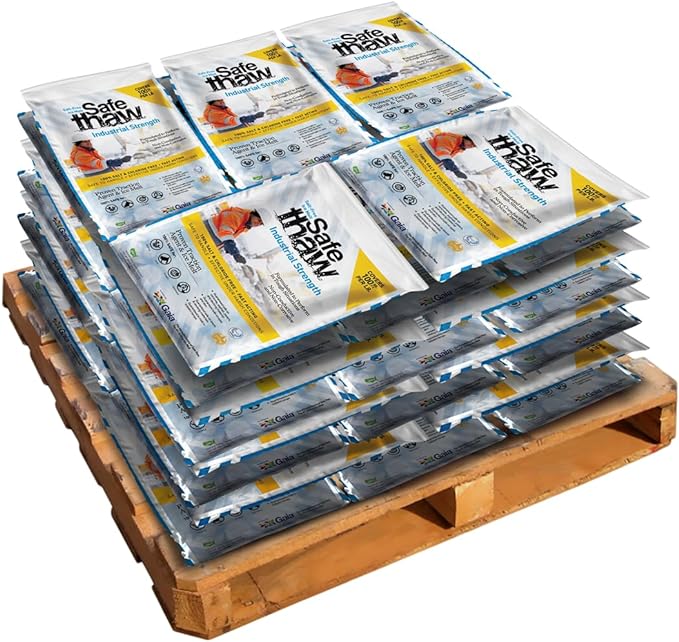
40 Bags
Safe Paw Thaw Industrial Strength Salt-Free Pet Safe Snow Ice Melter and Traction Agent for Concrete, Asphalt, Decks, Lawns, and More, 43 Pound Bag- 40 Bags
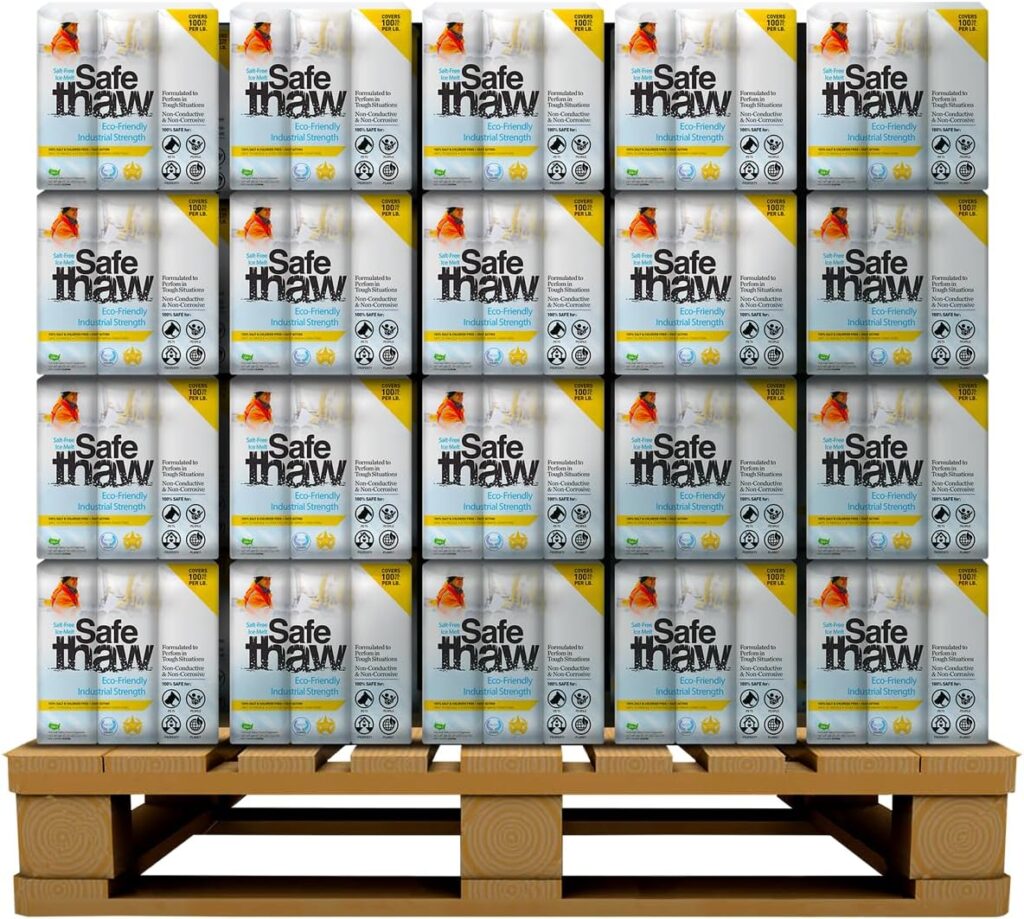
100 Boxes
Safe Thaw Industrial Strength 100% Salt/Chloride-Free, Pet/Paw-Safe Snow & Ice Melter and Traction Agent. Use on Concrete, Asphalt, Roofs & On Any Surface, 30 Pound FlexiPail- 100 Boxes
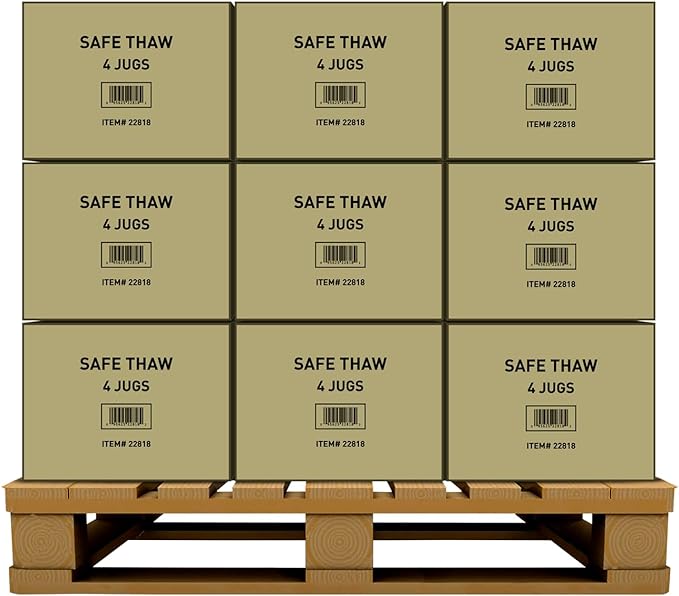
105 Jugs
Safe Thaw Concrete Safe 100% Salt-Free, Pet Safe Snow and ice Melter, Industrial Strength, Chloride-Free, and Traction Agent. Use on Asphalt, Roofs & On Any Surface, 10 Pound Jug- 105 Jugs
Long-Term Maintenance for Concrete Pavers
Proper maintenance of your pavers ensures they remain in excellent condition throughout winter and beyond.
Sealing Your Pavers
Apply a high-quality sealer to create a protective barrier against moisture and deicing chemicals. Reseal every two to three years to maintain effectiveness.
Regular Cleaning
Remove debris and stains promptly to prevent damage. Cleaning your pavers after the winter season removes residual salts and other contaminants.
Inspect for Damage
Check for cracks or loose pavers before winter begins. Repairing minor issues prevents them from worsening due to freeze-thaw cycles.
How to Melt Ice on Pavers Safely
To ensure safety and effectiveness, follow these steps when melting ice on pavers:
- Choose the Right Product: Opt for the best ice melt for pavers that is chloride-free and eco-friendly.
- Apply Sparingly: Use the recommended amount to avoid overapplication.
- Sweep Up Residue: Once the ice has melted, remove any remaining product to prevent buildup.
- Combine Methods: Use mechanical removal or sand alongside ice melt for optimal results.
Safe Thaw: The Safest Ice Melt For Concrete
Concrete is somewhat porous, and water can easily seep into the concrete through pores or minute cracks; if that water gets the opportunity to freeze within your concrete, it can create large cracks and gaps. Safe Thaw, a urea-based ice melt, is the perfect solution to this problem as it doesn’t allow the water brine to refreeze and helps prevent cracks on concrete.
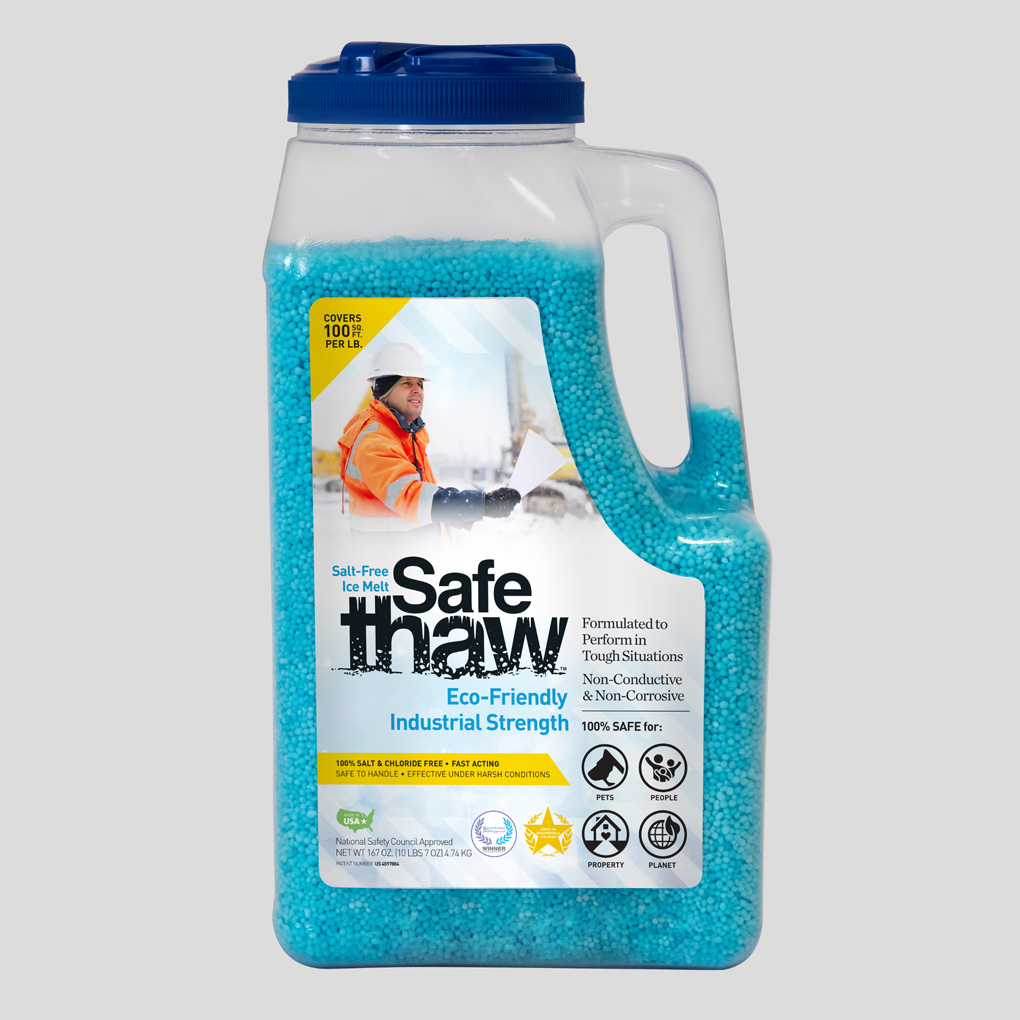
Safe Thaw
Safe Thaw was created as the ice management solution for tough winter environments. Ideal in commercial and industrial properties, shops, government agencies, bridges, and construction.
Safe Thaw is a chloride-free industrial ice melt that is not only highly effective at melting ice and snow but also safe for concrete, pets, and the environment.
Here are some reasons why Safe Thaw is the ideal choice for your pavers, parking lots, and patios:
- Chloride-Free: Safe Thaw is free from harmful chlorides that can corrode and damage concrete surfaces over time.
- Safe for Pets: It won’t harm your furry friends’ paws, making it a safe choice for homes with pets.
- Safe for Concrete: Safe Thaw is non-corrosive and won’t harm concrete, including pavers, patios, and parking lots.
- Fast-Acting: Its patented dual-effect formula quickly breaks surface tension and melts ice, making it highly efficient.
- Eco-Friendly: Safe Thaw is environmentally friendly, making it a responsible choice for those who care about the planet.
100% salt & chloride-free, fast acting Ice Management Solution
Conclusion
Melting ice on concrete pavers requires a careful balance between effectiveness, safety, and environmental responsibility. By selecting the best ice melt for pavers and incorporating alternative methods, you can maintain safe and clean surfaces without compromising your pavers’ integrity.
Eco-friendly and pet-safe products like Safe Thaw are excellent choices for managing winter challenges. Combined with long-term maintenance practices, such as sealing and regular cleaning, these strategies will keep your pavers looking great and performing well year-round.
FAQs
Try Also Our Other Winter Safety Products:
Traction Magic
Stay safe on slippery surfaces with a product that’s 100% natural and safe for pets, people, and your property. Whether it’s sidewalks, steps, or even your car’s traction, Traction Magic is the go-to choice.
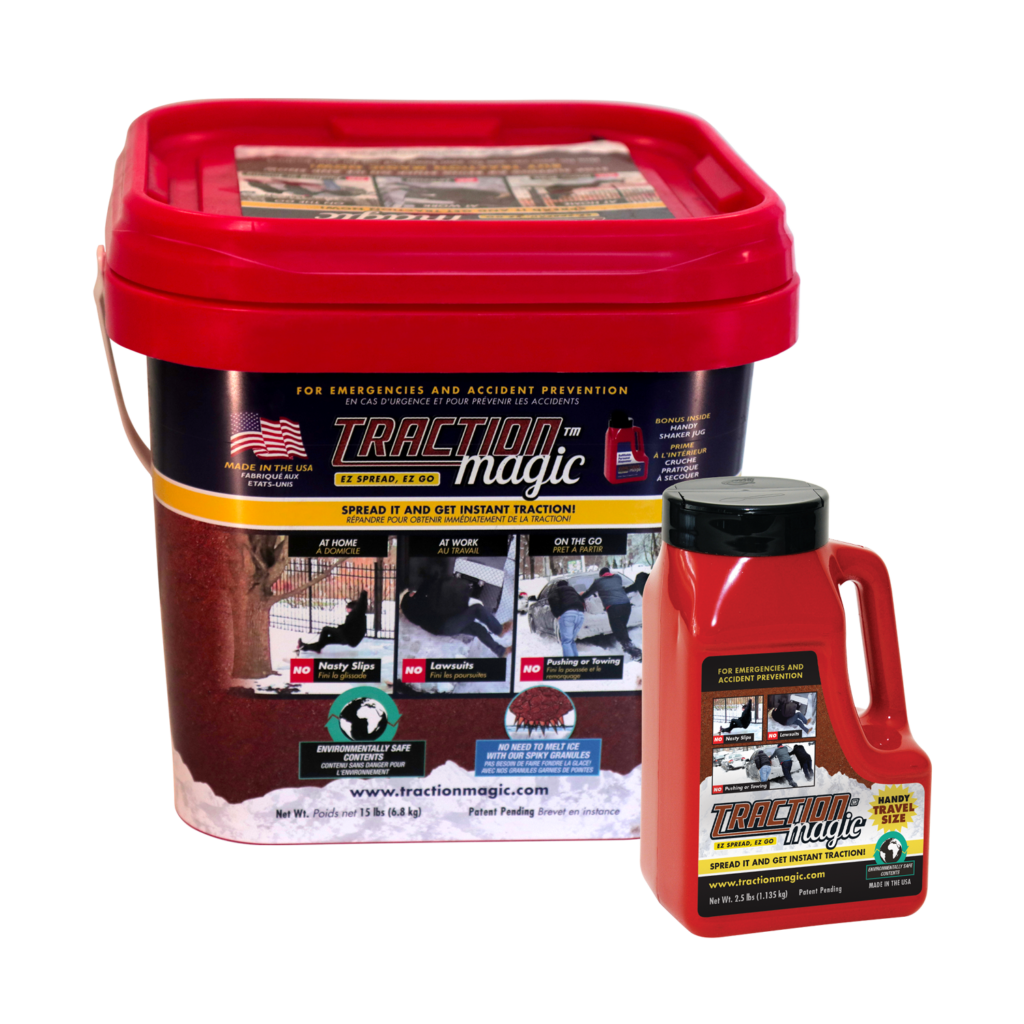
Walk On Ice
The handy disposable canister can be taken everywhere, with the same 100% naturally occurring minerals that provide instant traction on ice or snow. Use it on sidewalks, steps, or as an instant traction agent for your car.
